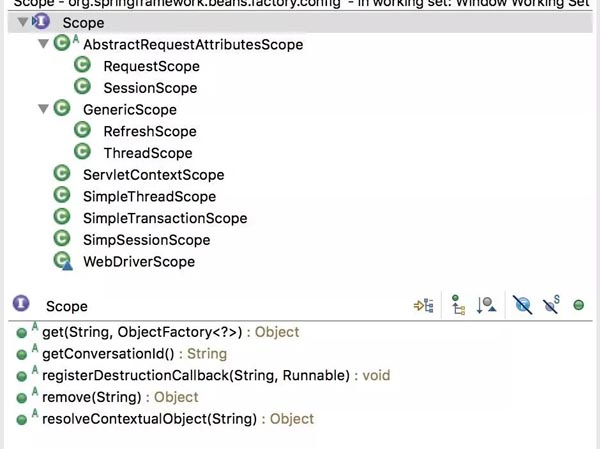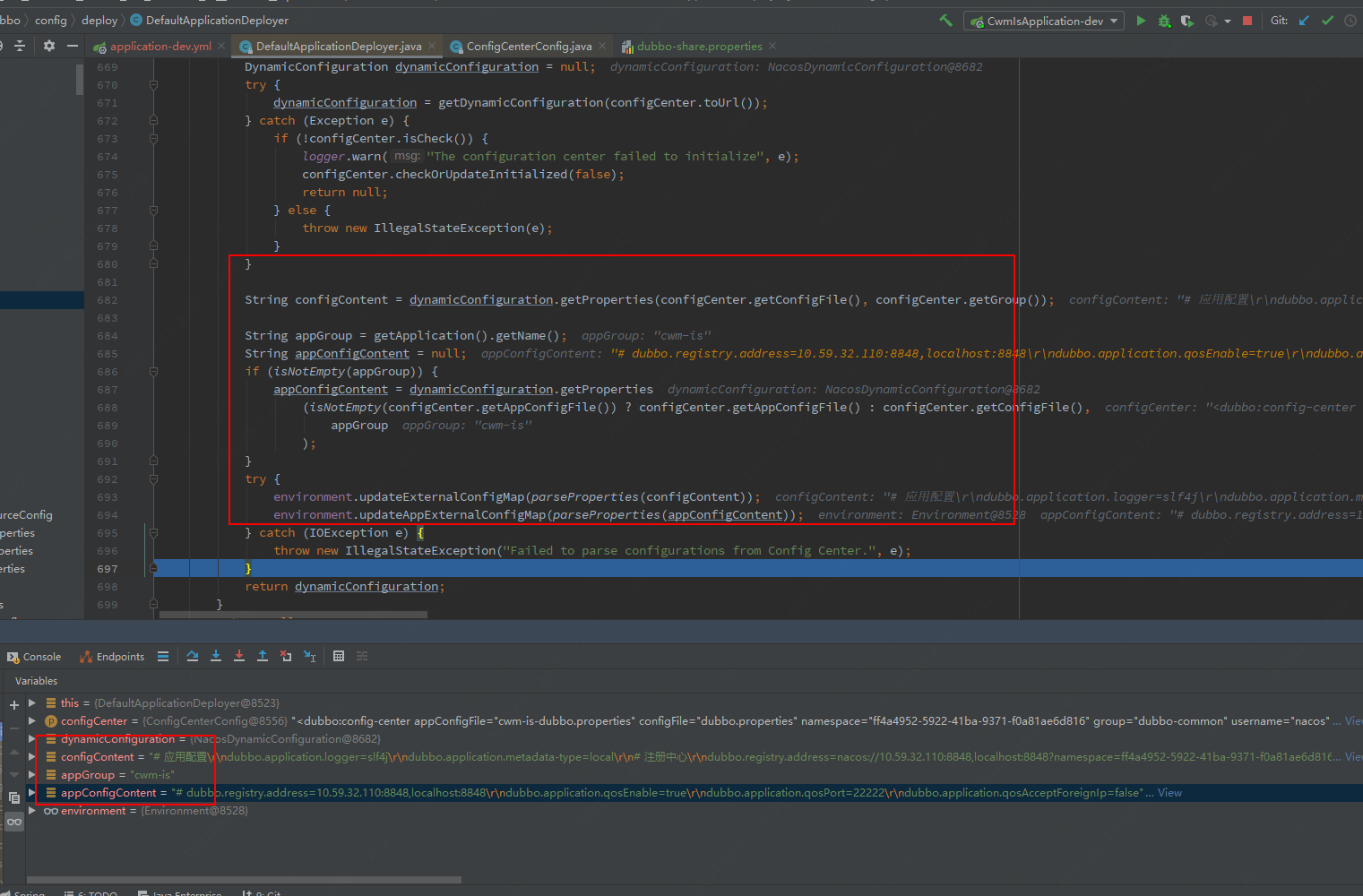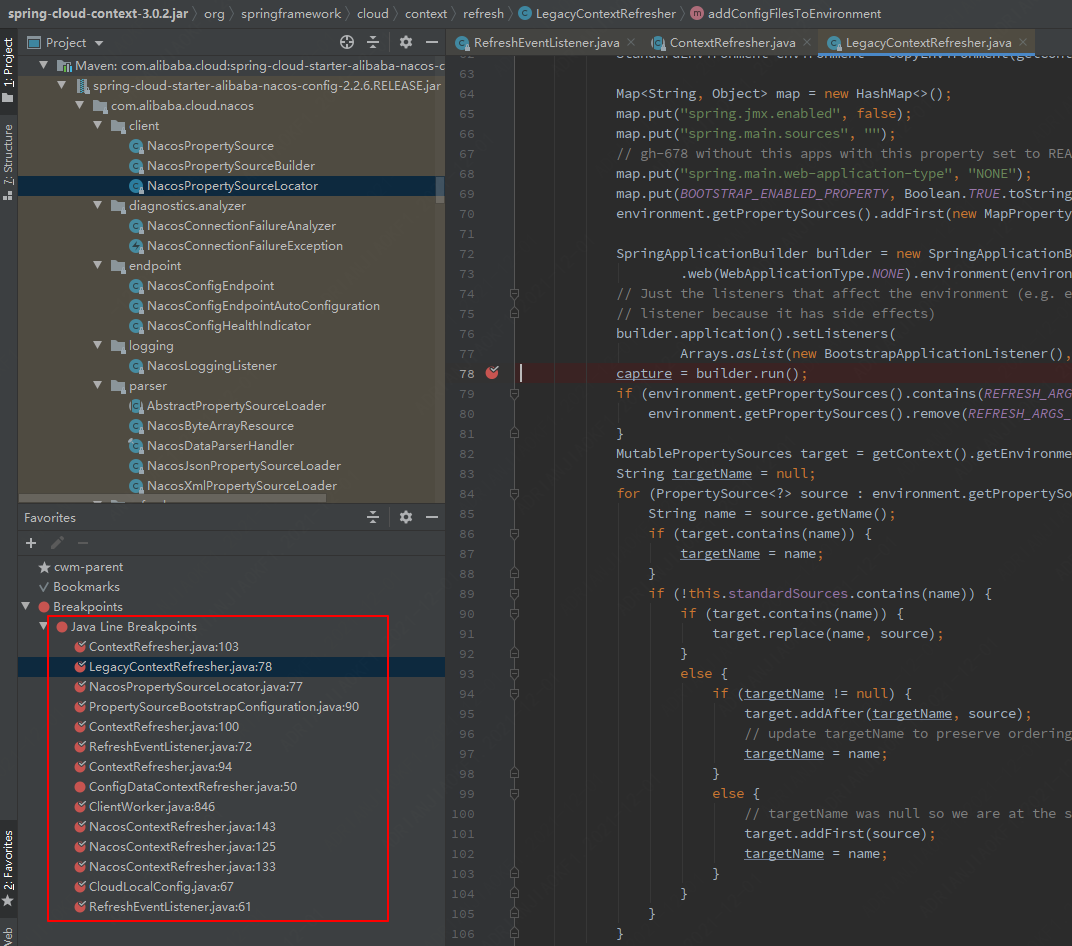@RefreshScope那些事
要说清楚RefreshScope,先要了解Scope
- Scope(org.springframework.beans.factory.config.Scope)是Spring 2.0开始就有的核心的概念
- RefreshScope(org.springframework.cloud.context.scope.refresh)是spring cloud提供的一种特殊的scope实现,用来实现配置、实例热加载。
- Scope -> GenericScope -> RefreshScope

1. Scope与ApplicationContext生命周期
AbstractBeanFactory#doGetBean创建Bean实例
protected <T> T doGetBean(...){final RootBeanDefinition mbd = ...if (mbd.isSingleton()) {...} else if (mbd.isPrototype())...} else {String scopeName = mbd.getScope();final Scope scope = this.scopes.get(scopeName);Object scopedInstance = scope.get(beanName, new ObjectFactory<Object>() {...});...}...}
Singleton和Prototype是硬编码的,并不是Scope子类。 Scope实际上是自定义扩展的接口
Scope Bean实例交由Scope自己创建,例如SessionScope是从Session中获取实例的,ThreadScope是从ThreadLocal中获取的,而RefreshScope是在内建缓存中获取的。
2. @Scope 对象的实例化
@RefreshScope 是scopeName=”refresh”的 @Scope
...@Scope("refresh")public @interface RefreshScope {...}
@Scope 的注册 AnnotatedBeanDefinitionReader#registerBean
public void registerBean(...){...ScopeMetadata scopeMetadata = this.scopeMetadataResolver.resolveScopeMetadata(abd);abd.setScope(scopeMetadata.getScopeName());...definitionHolder = AnnotationConfigUtils.applyScopedProxyMode(scopeMetadata, definitionHolder, this.registry);}
读取@Scope元数据, AnnotationScopeMetadataResolver#resolveScopeMetadata
public ScopeMetadata resolveScopeMetadata(BeanDefinition definition) {AnnotationAttributes attributes = AnnotationConfigUtils.attributesFor(annDef.getMetadata(), Scope.class);if (attributes != null) {metadata.setScopeName(attributes.getString("value"));ScopedProxyMode proxyMode = attributes.getEnum("proxyMode");if (proxyMode == null || proxyMode == ScopedProxyMode.DEFAULT) {proxyMode = this.defaultProxyMode;}metadata.setScopedProxyMode(proxyMode);}}
Scope实例对象通过ScopedProxyFactoryBean创建,其中通过AOP使其实现ScopedObject接口,这里不再展开
现在来说说RefreshScope是如何实现配置和实例刷新的
RefreshScope注册
RefreshAutoConfiguration#RefreshScopeConfiguration
@Component@ConditionalOnMissingBean(RefreshScope.class)protected static class RefreshScopeConfiguration implements BeanDefinitionRegistryPostProcessor{...registry.registerBeanDefinition("refreshScope",BeanDefinitionBuilder.genericBeanDefinition(RefreshScope.class).setRole(BeanDefinition.ROLE_INFRASTRUCTURE).getBeanDefinition());...}
RefreshScope extends GenericScope, 大部分逻辑在 GenericScope 中
GenericScope#postProcessBeanFactory 中向AbstractBeanFactory注册自己
public class GenericScope implements Scope, BeanFactoryPostProcessor...{@Overridepublic void postProcessBeanFactory(ConfigurableListableBeanFactory beanFactory)throws BeansException {beanFactory.registerScope(this.name/*refresh*/, this/*RefreshScope*/);...}}
3. RefreshScope 刷新过程
入口在ContextRefresher#refresh
refresh() {Map<String, Object> before = ①extract(this.context.getEnvironment().getPropertySources());②addConfigFilesToEnvironment();Set<String> keys = ④changes(before,③extract(this.context.getEnvironment().getPropertySources())).keySet();this.context.⑤publishEvent(new EnvironmentChangeEvent(keys));this.scope.⑥refreshAll();}
①提取标准参数(SYSTEM,JNDI,SERVLET)之外所有参数变量
②把原来的Environment里的参数放到一个新建的Spring Context容器下重新加载,完事之后关闭新容器
③提起更新过的参数(排除标准参数)
④比较出变更项
⑤发布环境变更事件,接收:EnvironmentChangeListener/LoggingRebinder
⑥RefreshScope用新的环境参数重新生成Bean
重新生成的过程很简单,清除refreshscope缓存幷销毁Bean,下次就会重新从BeanFactory获取一个新的实例(该实例使用新的配置)
RefreshScope#refreshAll
public void refreshAll() {<b>super.destroy();</b>this.context.publishEvent(new RefreshScopeRefreshedEvent());}GenericScope#destroypublic void destroy() {...Collection<BeanLifecycleWrapper> wrappers = <b>this.cache.clear()</b>;for (BeanLifecycleWrapper wrapper : wrappers) {<b>wrapper.destroy();</b>}}
4. Spring Cloud Bus 如何触发 Refresh
BusAutoConfiguration#BusRefreshConfiguration 发布一个RefreshBusEndpoint
@Configuration@ConditionalOnClass({ Endpoint.class, RefreshScope.class })protected static class BusRefreshConfiguration {@Configuration@ConditionalOnBean(ContextRefresher.class)@ConditionalOnProperty(value = "endpoints.spring.cloud.bus.refresh.enabled", matchIfMissing = true)protected static class BusRefreshEndpointConfiguration {@Beanpublic RefreshBusEndpoint refreshBusEndpoint(ApplicationContext context,BusProperties bus) {return new RefreshBusEndpoint(context, bus.getId());}}}
RefreshBusEndpoint 会从http端口触发广播RefreshRemoteApplicationEvent事件
@Endpoint(id = "bus-refresh")public class RefreshBusEndpoint extends AbstractBusEndpoint {public void busRefresh() {publish(new RefreshRemoteApplicationEvent(this, getInstanceId(), null));}}
BusAutoConfiguration#refreshListener 负责接收事件(所有配置bus的节点)
@Bean@ConditionalOnProperty(value = "spring.cloud.bus.refresh.enabled", matchIfMissing = true)@ConditionalOnBean(ContextRefresher.class)public RefreshListener refreshListener(ContextRefresher contextRefresher) {return new RefreshListener(contextRefresher);}
RefreshListener#onApplicationEvent 触发 ContextRefresher
public void onApplicationEvent(RefreshRemoteApplicationEvent event) {Set<String> keys = contextRefresher.refresh();}
大部分需要更新的服务需要打上@RefreshScope, EurekaClient是如何配置更新的
EurekaClientAutoConfiguration#RefreshableEurekaClientConfiguration
@Configuration@ConditionalOnRefreshScopeprotected static class RefreshableEurekaClientConfiguration{@Bean@RefreshScopepublic EurekaClient eurekaClient(...) {return new CloudEurekaClient(manager, config, this.optionalArgs,this.context);}@Bean@RefreshScopepublic ApplicationInfoManager eurekaApplicationInfoManager(...) {...return new ApplicationInfoManager(config, instanceInfo);}}
5. Nacos结合SpringCloud动态刷新原理
- 监听Nacos中配置更新

2.监听到变更的key,发送 EnvironmentChangeEvent 变更
- 发送事件通知后,updateEnviroment()方法会最终调用NacosProetySourceLocator,更新Environment中的Properties的值,在发送EnviromentChangeEvent, 去Rebind对应的Bean,达到重新刷新的目的
6. Dubbo自带配置中心原理
- 自行向Nacos注册了一些Dubbo自己需要监听的配置

- Dubbo自带配置中心启动时配置覆盖原理




